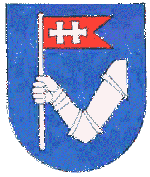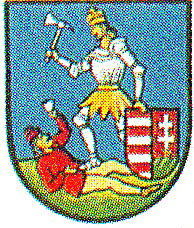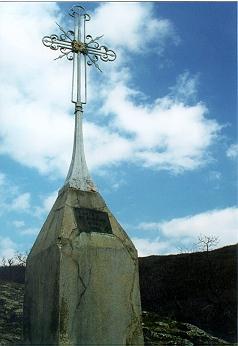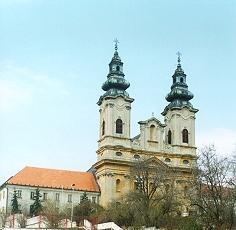
Coat of Arms of Nitra

Coat of arms of former Nitra county

Monument to St. Svorad in Zobor hill with 400 years-old cross originated from razed St. James church.

The Church of Piarists of 17th century
The growth of population in Nitra:
1849 - 10 000 inhabitants
1877 - 12 000
1890 - 13 500
1910 - 16 400
1921 - 19 100
1938 - 21 300
1950 - 22 200
1961 - 34 250
1970 - 45 000
1980 - 76 000
1991 - 90 000
Various forms of city name as has appeared in the past:
Nitrava
Nitria
Neutra
Nyitra
Nitra
Diocese of Nitria, (Nitriensis)
There are sources in the literature saying that thanks to Fridigit, wife of Rosemund, the Marconian chief, the see in Nitra was established by Archbishop Wolf of Lorch in the middle of the fourth century.
|
Nitra is the oldest Slovak city situated in western part of Slovakia occupying both banks of Nitra river with beautiful panorama of Zobor hill.
828 AD - Nitra (Nitrava) for the first time mentioned in written document (De Conversio Bagoarorum et Corantanorum). Duke /Prince/ Pribina built the first christian church in the territory of Slovakia for his Bavarian wife. The church was consecrated by Adalram, Archbishop of Salzburg. Nitra was the center of duchy /principality/ at that time.
833 - Nitra duchy was annexed to Moravian duchy by duke Moimir to create Great Moravian Empire. Pribina had to flee. However, the name Great Moravia was mentioned for the first time in 950 by Byzantine Emperor Constantinus Porfyrogenetos.
863 - Princ Rastislao asked Byzantine Emperor Michael III to send him a bishop and religion teachers. The Emperor sent him brothers Cyril and Methodius, coming from Thessalonika, for their mission. They spread christianity in this region and created clergy from local people. They introduced the first Slavonic alphabet - glagolitic and translated religious literature in the Slavonic language. The language of the Slavs became the fourth liturgical language together with Hebrew, Latin and Greek.
880 - At the request of the king Svätopluk, the pope John VIII issued the bull Industriae Tuae and established the first bishopric in the territory of Slovakia and central and eastern Europe. Methodius was appointed as Archbishop of Moravia and Pannonia. As the Bishop of Nitra was chosen Wiching. The first monastery in Slovakia, benedictine, built probably at that time in Nitra as well.
894 - After death of Svätopluk in 894, his older son Moimir II ruled over the Empire. His brother Svätopluk II seated in Nitra as duke stood under Moimir II. Great Morava was attacked more and more by Hungarian troops and both brothers struggled for the power between themselves, so the Empire was gradually falling down.
920 - Hungarians troops had penetrated the territory of Nitra duchy and have controlled substantial part of the territory. When Hungarian Kingdom was created Nitra was transformed into a border apanage duchy /principality/. It means that Nitra was a seat of non-ruling younger brother of Arpad dynasty and Nitra has kept a relative independence within the Kingdom. Nitra had commanded the troops of its own and even had minted own coins which had had higher value than royal coins. The duchy had stretched almost over all modern territory of Slovakia except for the most eastern part, called Zemplín, but included northern part of today Hungary.
1106 - This status of Nitra had lasted until 1106. The king Koloman had got his younger brother Almos blind becouse strong position of Nitra within the kingdom hindered him. Then Nitra had lost its position as a seat of duke where during centuries the dynasties of Pribina, Moimir and Arpad were consecutively ruling.
1110 - King Koloman re-established a bishopric in Nitra. The first bishop became Gervasius.
1241 - Nitra resisted to the Tartars attack.
1248 - September 2, King Belo IV granted priviledges to the town and Nitra became a free royal town. Since then the residents had been appointing their magistrate and town council, they were allowed to organize the market the tolls from market went to the town. It faciliated further development of trades and crafts in the town. As for the ethnic groups the most popupation were Slovaks and Hungarians together with Germans and Jewish minority. The total number of inhabitants was about 2 000 - 2 500.
1288 - King Ladislav IV passed Nitra over to the bishop Pashko. Nitra lost some of its priviledges, eg grounds of the town fell to the bishop etc.
1317 - 1321 - The castle and town plundered by Matus Cak of Trencin who ruled over considerable part of Slovakia.
1431 The castle conquered by hussites.
15. century - Nitra was important center of the county administrative and one of the most important ecclesiastical center in Slovakia. The bishop of Nitra multiplied the power as a zhupan /head of the county - zhupa - administrative/ and used to be Hungarian Chancelor as well. The bishop and the town shared the tolls from regular markets.
16. - 17. century - The history of Nitra in 16. and 17. century is connected with the Turks wars and several revolts. In the half of 15. century the Turks reached the Danube river and Nitra had important function in defensive system and consequently new fortification of the castle was built.
1605 -1607 - The first anti Habsburg revolt. The town was in hands of the insurgents which devastated Nitra.
1622 - 1642 - Bishop Jan Telegdy ordered to rebuild church cathedral and the castle and called the franciscans. They built their own church and monastery in Upper town in 1630.
1663 - The Turks seized Nove Zamky fortress and Nitra was in immediate danger. Turk army attacked Nitra but the garrison handed the town over to the turks without any fight. The Emperor´s army won Nitra back in 1664.
1698 - The Piarists came to Nitra and established a higher grammar school which later became one of the best in the Kingdom. In the first half of the 18. century they finished building their own two-spired church dominating panorama of Nitra since then.
1703 - Anti-Habsburg revolt under leadership of Ferdinand II Rakoczi in Hungarian Kingdom. The insurgents gradually ruled over most country and in 1704 Nitra castle defeated after several weeks of sieging and this was the important strategic point for the troops until 1709 when the Emperor´s army conquered Nitra.
1711 - The Turks wars and revolts are over and the whole country ready for sweeping reforms in the period called the Enlightement. Nitra was strongly damaged and in the next years was built a lot of valuable buildings primarily in baroque style.
1766 - The streets of the town cobbled.
1777 - Queen Mary Theresa took away from the bishops right to be the zhupan and since then another person had been leading the administration of the zhupa. Nitra was important administrative and ecclesiastical center of Hungarian Kingdom.
1848 - 1849 - Revolution events. Slovak anti-hungarian uprising. The Emperor´s army with slovak volunteers defeated hungarian revolt. After the revolution Nitra incorporated surrounding quarters and reached 10 000 inhabitants.
1863 - The first financial institution in Nitra - Nitra savings house.
1864 - The steam mill put in operation.
1867 - Austro-Hungarian relationship and so-called dual monarchy established. This brought hard enforcement of hungarian language for non-hungarian nations.
1881 - Nitra connected to Nove Zamky and Topolcany by railway.
1890 - Public gas lighting introduced to the city.
1896 - A malthouse and a brewery production launched.
1900 - The first cinema built in the city.
1901 - 1903 - Ministry of Justice built a representative building in art Nouveau style in Nitra.
1915 - Electricity introduced in the whole city.
1914 - 1918 - World War I.
1918, 28. October - The first Czechoslovak Republic established. Nitra the fifth largest Slovak town and still a seat of zhupa administration. The growth of the population was very slow during the first Czechoslovak Republic and the city faced considerable unemployment rate. Despite this Nitra became agriculture center of southwestern Slovakia. The biggest employers in industrial field was the steam mill, the ferrenit factory, the malthouse and the brewery.
1933 - The Pribina festival held at Nitra to celebrate the 1100. anniversary of the first christian church built in Slovakia and 300 000 people took part in this event.
1939, 14. March - The Slovak State established and Slovakia lost a part of its territory at the expense of Hungary and Nitra found itself 15 kms from newly created border.
1945, 30. March - The World War II over for Nitra. The material losses caused by War in Nitra exceeded 22 000 000 czechoslovak crowns.
1946 - The last free election before communist takeover. The winner is Democratic Party.
1948 - After the takeover Communist regime was introduced.
To Be Continued
|


